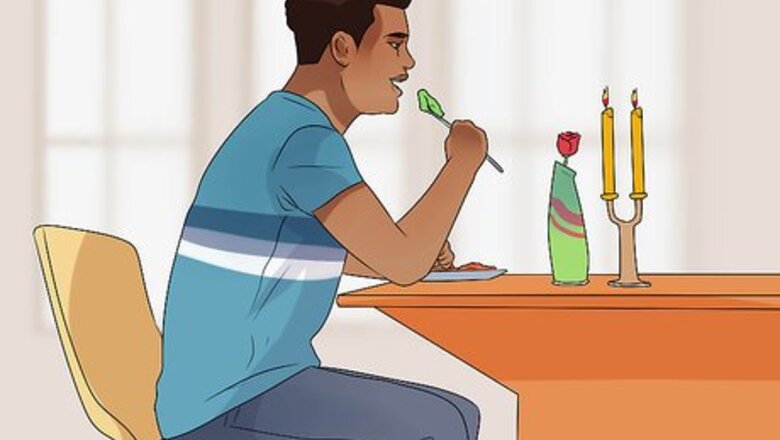
views
Establishing the Right Environment

Sit down for each meal. If you're eating on the run, or in front of the TV, you're more likely to scarf your food. You will not pay as close attention to your food in an area filled with distractions. Make a point of sitting down at your kitchen table for every meal. Even if it's just you eating, make a point of setting the table. This can make the experience of eating feel more personal and intimate, which may encourage you to eat slowly. You can also do something to make meal time feel special. For example, light a candle or set down flowers. You can also cook your own food. If you made a meal yourself, you may be more likely to savor each bite.

Try to eat with others. If you're engaged in conversation while eating, this may slow you down some. Whenever possible, try to eat with other people. If you live with your family, try to make family meal nights a regular occurrence. Not only will this slow down your eating, it can also increase the feeling of family togetherness. If you live with roommates, consider having a dinner with your roommates a few nights a week. Everyone can agree to prepare a dish. If you live alone, try inviting friends over for dinner or eating out at a healthy restaurant a few nights a week.
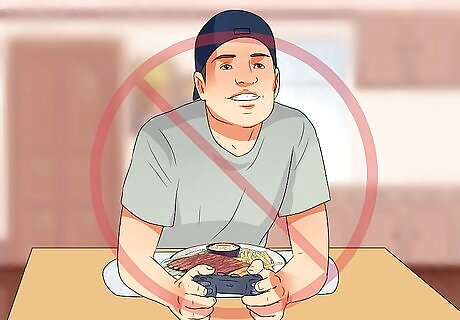
Do not do anything else while you eat. If you're watching television, reading, or doing something like a crossword puzzle, you're unlikely to pay attention to your food. This can encourage you to scarf your food down instead of taking the time to enjoy it. Practice mindful eating, really paying attention to the food and your surroundings. Eliminate distractions before meal time. Leave your phone in the other room, turn off your laptop, and turn off your television set. Do not bring reading materials to the table. Try to make meal time into a ritual where you make a point of appreciating your meal. Try to look at your food just before eating. Strive to appreciate the meal in and of itself.

Get a drink for yourself. Never neglect a beverage when eating. Drinking can help slow the pace of your eating as you'll have to stop to take sips of a drink. Liquid can can also help fill you up, which can prevent overeating. Before sitting down for a meal, make sure to pour yourself a drink. It's a good idea to go for low calorie or calorie-free beverages, especially if slow eating is part of a weight loss regimen. Water, diet soda, and seltzer water are good options.
Making an Effort to Eat Slowly
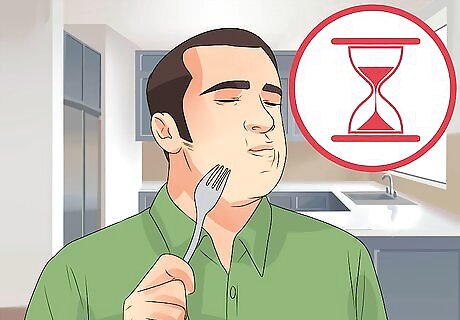
Chew more. Chewing your food more will help bring your focus back to your meal. It will also help you delay the time between taking a bite and swallowing. Try to chew between 10 and 15 seconds before swallowing. It can also help to opt for meals made from foods that are difficult to swallow. For example, try to eat a diet rich in vegetables, fresh fruits, and lean proteins. Softer foods, like casseroles and mashed potatoes, may be harder to chew for prolonged periods. Concentrate on the flavor and texture when you chew. Try to be aware of the fact you are eating, and stop to think about how much you're enjoying your food.

Sip water between each bite. This is why pouring yourself a drink before a meal can help. Water is especially helpful, as it contains no calories. Between each bite, make sure to take a sip of water. This will slow down the pace of your eating and help fill you up faster. It can help to flavor your water to make it more enticing. You can buy flavored water at the supermarket. You can also add pieces of fruit or vegetables to tap water to give it extra flavor.
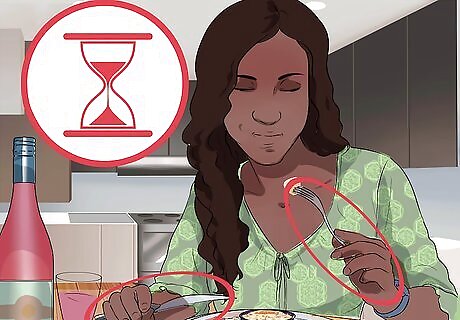
Set down your utensils between bites. This is a small change, but it can really slow down the pace of your eating. If you hold onto your utensils for the entire meal, you will go into shoveling mode. Setting down your utensils between each bite will force you to stop and savor the meal a little more. You can also try eating with smaller utensils. This can encourage you to take smaller bites. Try switching up the utensils you use. You can, for example, eat with chopsticks for a change to slow down the pace of your eating.
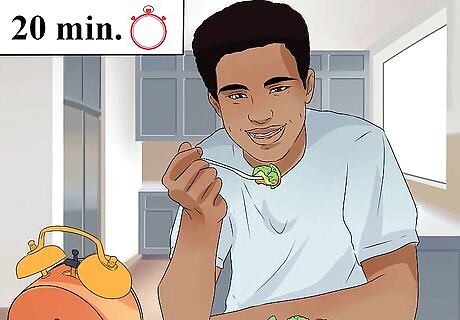
Time yourself. If you're really struggling with the pace of your eating, try actually setting a timer. This will challenge you to increase the amount of time you spend eating your food. Ideally, it should take you around 20 minutes to finish a meal. Try setting the kitchen clock for 20 minutes. Keep an eye on the clock as you eat, and strive to take 20 minutes to finish your plate. You can try to eat your food in servings. For example, eat your salad first, then your side dishes, then your main course.
Changing Your Overall Eating Habits
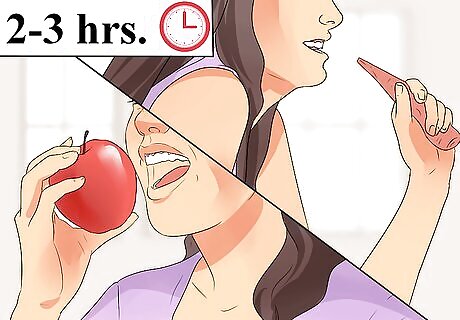
Eat every 3-4 hours. Waiting long periods between eating can leave you feeling starved. If you're extra hungry, you're more likely to wolf down food. Instead of eating 3 large meals a day, make a point of eating a small meal every 3 or 4 hours. Make sure to be aware of calories. If you're eating every 2 to 3 hours, you need to keep the caloric content of your meals lighter than you would when eating 3 meals a day. In addition to helping you eat more slowly, this can rev up your metabolism.
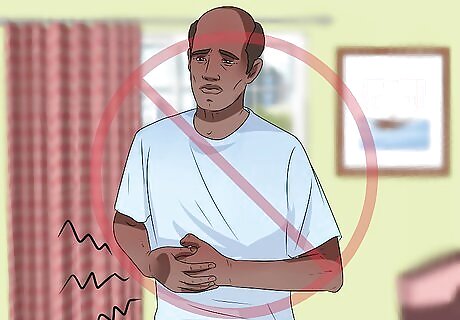
Do not let yourself get too hungry. If you end up starving by the end of the day, you're likely to binge eat. If your stomach is growling and you're feeling extreme hunger pangs, you've let yourself go too long between meals. When you feel a small amount of hunger building, start planning on what to eat. Strive to have a snack within the next half hour or so.
Plan your meals ahead of time. Part of the challenge with eating healthy can be the time investment. Try creating 2-3 big recipes each week, then portion them into airtight containers and eat those meals on the days of the week when you're really busy. That can be a big step towards making healthy eating feel like less of a chore. Stock up on easy-to-grab snack foods like fresh fruits, vegetables sticks, hummus, guacamole, pesto, raw almond butter, nuts, and avocado.
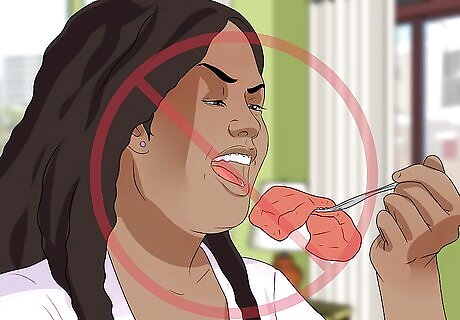
Eat smaller portions. Small portions can force you to savor your food and eat more slowly. Work on being aware of serving sizes. Strive to eat nutrient dense meals in smaller portions. Make sure to read nutrition labels. This will give you the idea of an actual serving size. A bag of chips may say it's only 150 calories, but the serving size may be half the bag. Use small visual cues to determine portion size. A serving of carbohydrates is about the size of a hockey puck. A serving of protein should be no bigger than a deck of cards.
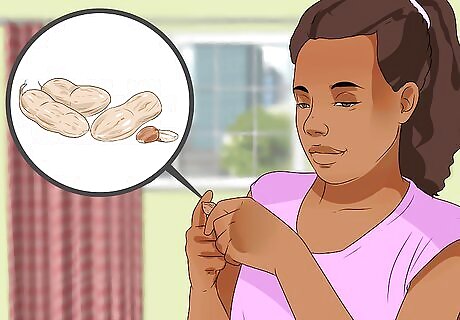
Snack on shelled foods. If you feel hungry between meals, have a snack. Stick to something like peanuts or pistachios. If you have to open the shell of a food to eat it, you will have to slow the pace of your eating. Be careful, however, when eating nuts. They tend to be high in calories. You can also try eating foods that you eat one at a time. For example, snack on blueberries but don't eat them in handfuls. Focus on one blueberry at a time.

















Comments
0 comment